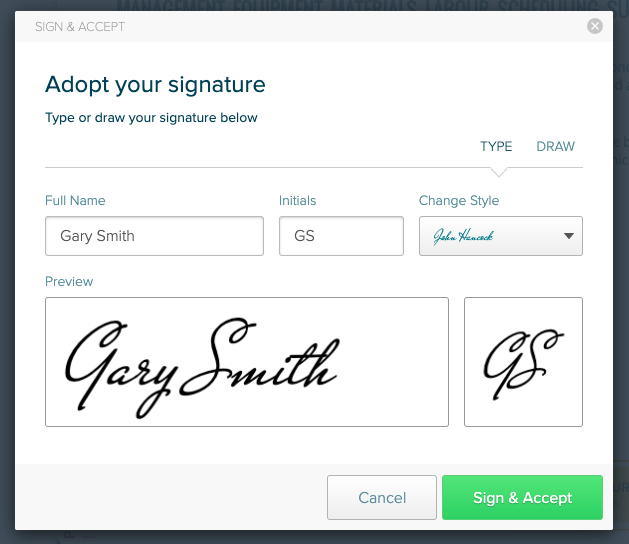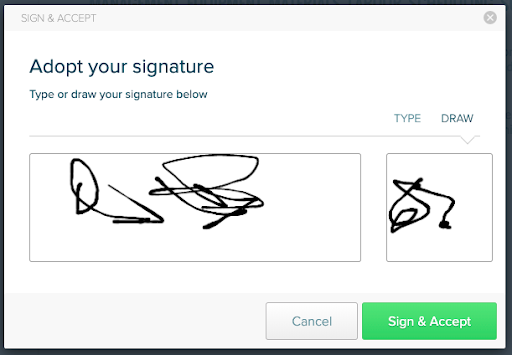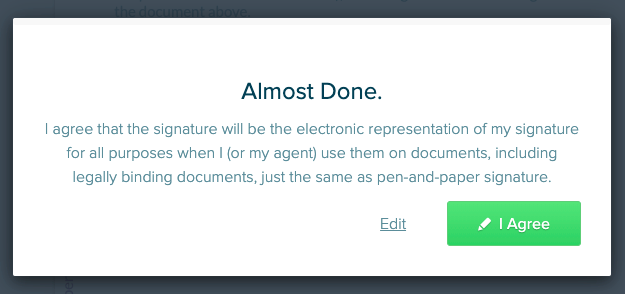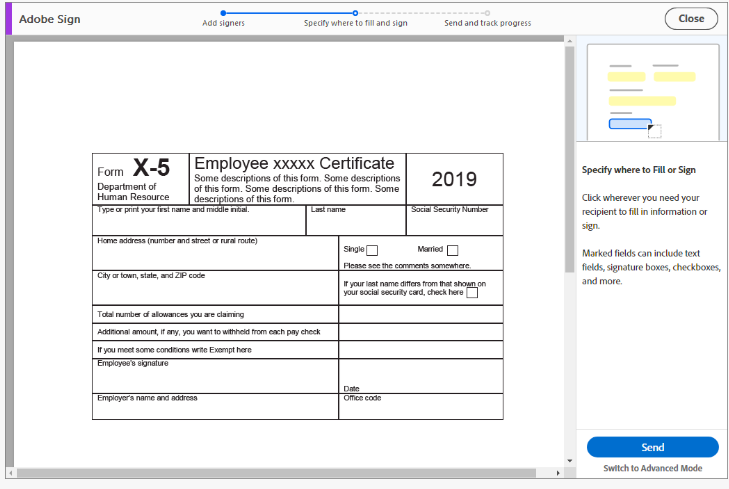Electronic Signatures: Why & How to Use Them in Your Online Proposals
Published: October 15, 2019Updated: December 20, 2024

Customer expectations are changing. Have your proposals? If your sales team’s close rate still counts on every client printing, signing, scanning, and sending back your proposals, your proposal sign-off process is stuck in the ‘90s. Here’s why creating and using online signatures is the simple, modern way to close deals faster, plus I take a look at the top electronic signature apps available today.
You’ve been there before.
You’ve sent a proposal and are anxiously waiting for your client to send it back, fully signed, so you can close the deal. But days later, you’re STILL waiting by your inbox.
What happened? Did the client change their mind?
Maybe it’s your sales team’s clunky, outdated sign-off process.
It might be taking forever to close because your clients have to...
physically print the proposal out...
then find a pen and sign it...
then go back to the printer to scan it...
and then email the file back to you?
A tedious, multi-step process like this would bring out the procrastinator in all of us, and your client is no exception. Here’s the thing, though: there’s a MUCH better way.
Electronic signatures aren’t new; in fact, they’ve been around for more than two decades now. Yet somehow sales teams still insist on staying stuck in the ‘80s and ‘90s with time-consuming physical sign-off processes.
Consider this: when we analyzed 1.6 million proposals in the Proposify database, we found that more than a quarter of winning proposals are signed online by the client within 11 minutes.
ELEVEN. MINUTES.
That’s the magic of online signatures. I mean, it could take someone trying to print and sign a traditional paper contract that long just to add more toner to the printer.
This staggering stat alone should be enough to convince you that online signatures make the proposal process smoother for you and your clients.
But just in case you need more convincing, I have more details and benefits that will make you an esignature believer
Quick! Grab this game-changing guide for your sales team (before your competitors do…)
Download The Closer’s Guide to Winning Proposals for free and gain the edge.

Electronic signatures vs. digital signatures
Digital signatures
A digital signature is encrypted using cryptographic algorithms, which in layman's terms means your “signature” is turned into data that prevents unauthorized access. This secures the information of the document and also certifies that it’s been signed.
Electronic signatures
While an electronic signature also collects general data to ensure the identity of the person signing, it also captures the legal intent to sign a document.
Signing can be as simple as checking a box, typing or drawing your signature, or even verbal authorization.
For esignatures, authorization is any form of sound, symbol, or process that shows the sender that you have gone over the document and intend to sign. The mark you make IS the data that secures your document and certifies it’s been signed.
The term 'electronic signature' means an electronic sound, symbol, or process, attached to or logically associated with a contract or other record and executed or adopted by a person with the intent to sign the record.
- ESIGN Act, Sec. 106 (U.S. Federal Law)
Proposify provides two ways to sign your proposal electronically to give you more customization.
You can type in your name and select your desired font style to display it in:

Or show off your top-notch mouse-drawing skills, like Gary here:

I’m sure that says ‘Gary Smith’ in there somewhere.
Regardless of the font you choose or your (lack of) digital penmanship, the system will ask you to make it all legally binding by clicking your agreement.

Whether you type or draw your signature, it certifies your intent to sign and secures the document.
Are electronic signatures legally binding?
One reason some people are reluctant to use electronic signatures is that they incorrectly assume that it’s not as ‘legal’ as a paper signature.
Let’s say it again for the people in the back: electronic signatures can be legally binding. You just have to make sure that all your digital ducks are in a row.
There is national and international legislation on electronic signatures. Though the exact wording can vary based on the jurisdiction, there are common denominators found in most electronic signature legislation. They include:
- The signatory can be uniquely identified and linked to the signature.
- The signatory must have sole control of the private key that was used to create the electronic signature.
- The signature must be capable of identifying if its accompanying data has been tampered with after the message was signed.
- In the event that the accompanying data has been changed, the signature must be invalidated.
For example, here’s how we do it at Proposify.
Signees are emailed a unique link to the proposal, which validates them and allows them to sign as designated. Then, we record the IP address of the signing parties, along with the date and time it was signed.
Once it’s all signed, we offer both signees digital copies of the document and store them on our servers to retain a record of the electronic transaction.
To ensure the contract isn’t changed or modified after it’s been signed, we lock it down. If anything in the proposal is changed or edited, all parties involved are notified and any signatures are removed. The revised document would then need to be re-sent and re-signed by all signees.
We follow the steps outlined in the Electronic Signatures in Global and National Commerce Act and European Directive (EC/1999/93) to confirm electronic signatures in Proposify-generated proposals are legally binding.
While these acts give digitally-produced signatures the same stature as hand-written signatures, they do not cover some documents that demand more legal requirements, like divorce papers or last will and testaments.
If you’re ever unsure whether a signing method is legally binding, get your lawyer to check it over.
So now you know the how. What about the why?
I mean, besides the whole legally binding thing and that compelling under-15-minute sign-off stat, here are a few more benefits you may not have considered.
Why should I electronically sign a document?
Electronic signatures provide foolproof paperless back-up
If you’ve ever printed something important, you probably know the fear of losing sheets of your document or misplacing the whole thing.
It’s estimated that more than 70 percent of businesses would fail if they suffered a catastrophic loss of paper-based records due to fire or flood.
In the U.S., it is mandatory to retain records of any electronic transaction, in case you need to reproduce any of those documents for reference. It doesn’t have to be stored on paper, though.
When you sign digitally, a copy of your transaction is stored by the hosting site. Having a digital ‘paper’ trail also allows you to keep your documents in multiple places, like secure email, flash drives, and external hard-drives, making it easier to track or look up each document sent.
Electronic signatures are environmentally friendly
Storing paper documents not only takes up space but printing out each and every proposal or document is bad for the environment.
Consider these sobering stats:
- It takes 13 litres of water to make a standard sheet of printer paper. The average office worker uses 10,000 sheets per year.
- Since an average printer cartridge is 70 percent plastic, it takes approximately three to four litres of crude oil, a non-renewable resource, to produce one laser cartridge and up to 100 millilitres of crude oil to produce one ink cartridge.
- In many jurisdictions, printer waste, like toner powder or ink, is considered toxic and must be disposed of properly so hazardous compounds don’t leach into soil or groundwater.
Electronic signatures increase security
It might seem like requiring your client to physically sign a piece of paper to approve your proposal is safer than emailing them a document they can sign online.
However, most office printers are located in open areas and are shared by all employees. With lots of people printing at the same time, sheets of confidential paperwork run the risk of getting picked up along with another print job, filed away in the wrong place, or lost altogether.
Requiring someone to sign in to an account before they can send, view, or sign a document ensures that it will not end up in the hands of the wrong person.
Electronic signatures and digital signatures can be password-protected, eliminating the possibility of unauthorized people gaining access to confidential documents. Your clients can only access proposals with credentials you provide, so both you and your client sign into a secure account to view or sign the document.
Electronic signatures save time, money, and effort
If you went to an office supply store to buy a package of standard, 8.5 x 11 white printer paper, you probably wouldn’t end up with sticker shock when you got the register.
But if you think about all of the other steps that go into sending those hundreds of sheets of paper related to all the proposals you send every year, things can start to add up.
- Paper cost
- Printing cost
- Copying cost
- Scanning cost
- Delivery cost
- Safe document storage cost
By using online signatures, you can save up to $20 per document when you integrate digital signatures across various departments and processes. The ROI can be significant, and your company can start to see it almost immediately.
Online signatures also require less time and effort on both sides of the transaction. Clients can sign-off and get their project or contract started faster and your sales team doesn’t waste valuable selling time on unnecessary follow up.
What's the best electronic signature software?
Let's take a look at some of the most popular ways to add an electronic signature to proposals, quotes, contracts, and other sales documents.
Should I add an online signature to a Word document?
To create a digital signature in Word or another Microsoft Office product, like Excel or PowerPoint, you need to have a ‘signing certificate.’ This certificate is issued by a certification authority and is usually valid for one year.
Pros: Commonly-used and familiar business software
Cons: Time and cost to obtain and maintain certification; signatures aren’t tied to a specific contact or password-protected account; need to fill in the signature set-up fields for each instance; no tracking abilities; traditionally text-based medium.

Should I add an online signature to a PDF?
To add and/or sign a document in PDF form, you need to purchase and use the Fill and Sign tool via Adobe Sign. Your recipient can sign using the email link or using the Acrobat/Reader desktop app.
Pros: Specify your own authentication type, including email, password, or knowledge-based authentication.
Cons: PDFs tend to be static and can be uninspiring. They also don't provide a high level of security, as it has been noted by an Adobe expert that even a password-protected or encrypted PDF offers "about as much [security] strength as dried eggshells".
Should I add an online signature to a Google Doc?
In addition to the third-party apps you can download for Google Docs to enable signatures, there is also a hacky workaround to add a “signature”. (I use this term very loosely, as it’s not legally binding.)
You insert a drawing and then select the scribble tool to use your mouse to sign. From there you export your document as a PDF. This only really works if your document just needs your signature and not your client’s as well.
Pros: Free, easy to share documents
Cons: Not legally binding; not easy or elegant to have clients sign
Should I add an online signature to my proposal using secure, purpose-built software?
When you want to create signatures in your proposal, a built-in signature tool is ready and easy to use.
You may also be able to add extras that go beyond signatures for your signees, like client input forms and payment options. (Because the sign-off isn’t the end of the process, it’s the beginning of the relationship.)
Pros: No additional software or plugins required; no printing, downloads or scanning; easy-to-use process for signees; can support multiple signatures and initialling; compliant with strict worldwide electronic signature legislation; protected through bank-grade one-way encryption with daily, off-site backups; senders receive sign-off notifications.
Cons: If you’re not using purpose-built software like this, you’re missing out on all these features!
Conclusion
If you’re still signing documents by having people put pen to paper, you’re already behind. It’s well past time to break free from the tyranny of printers and the hassle of scanning.
Think about how long your typical client-signed sales document turnaround is. Now divide that by three. Online signatures are the most efficient way to sign proposals today, with the ultimate benefit of closing deals 32 percent faster.
The future of signed-on-the-dotted-line sales docs is digital.

![How to Add an E-Signature to a PDF Document [4 Easy Ways]](https://www.proposify.com/hs-fs/hubfs/Imported_Blog_Media/Blog-2023-05-01-PDF-e-signatures-v2-3.png?width=450&height=250&name=Blog-2023-05-01-PDF-e-signatures-v2-3.png)
